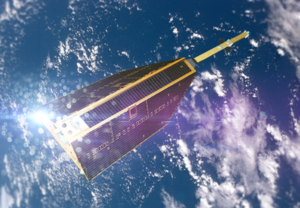Engineering:CHAMP (satellite)
From HandWiki
Revision as of 08:54, 29 July 2022 by imported>NBrush (over-write)
 Artist's impression of CHAMP | |
| Mission type | Technology |
|---|---|
| Operator | DLR |
| COSPAR ID | 2000-039B |
| SATCAT no. | 26405 |
| Mission duration | Achieved: 10 years Planned: 5 years |
| Spacecraft properties | |
| Bus | Flexbus |
| Manufacturer | Astrium |
| Launch mass | 500 kilograms (1,100 lb) |
| Start of mission | |
| Launch date | 15 July 2000, 12:00:00 UTC |
| Rocket | Kosmos-3M |
| Launch site | Plesetsk 132/1 |
| End of mission | |
| Decay date | 19 September 2010 |
| Orbital parameters | |
| Reference system | Geocentric |
| Regime | Low Earth |
| Semi-major axis | 6,823.287 kilometres (4,239.794 mi) |
| Eccentricity | 0.0007115 |
| Inclination | 87.18 degrees |
| Period | 93.55 minutes |
| RAAN | 124.21 degrees |
| Argument of perigee | 277.62 degrees |
| Epoch | 15 July 2000 12:00:00 UTC[1] |
Challenging Minisatellite Payload (CHAMP) was a Germany satellite launched July 15, 2000 from Plesetsk, Russia and was used for atmospheric and ionospheric research, as well as other geoscientific applications, such as GPS radio occultation.
CHAMP was managed by GeoForschungsZentrum (GFZ) Potsdam.
The spacecraft is the first application of Astrium's "Flexbus" platform; GRACE was the second. A heavily modified version flew as the GOCE mission.
CHAMP completed its mission and re-entered the Earth's atmosphere on 19 September 2010 after 10 years (design life: five years).[2]
The mission was judged as being successful by the involved scientists.[3]
References
- ↑ "Launch/Orbital Information for CHAMP". NASA. https://nssdc.gsfc.nasa.gov/nmc/spacecraft/display.action?id=2000-039B.
- ↑ "Upcoming and Recent Reentries | The Aerospace Corporation". Reentrynews.aero.org. http://reentrynews.aero.org/2000039b.html. Retrieved 2013-08-01.
- ↑ [1] [|permanent dead link|dead link}}]
External links

